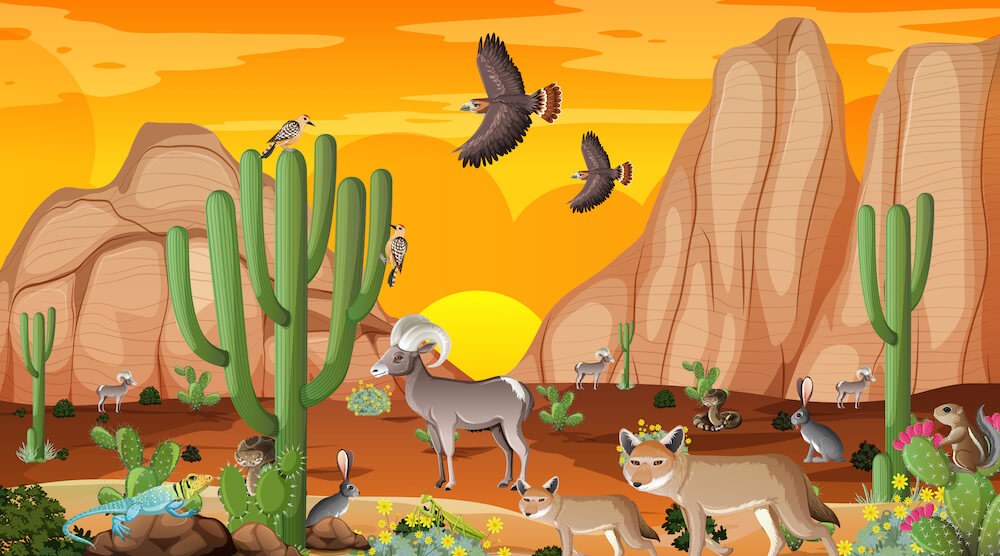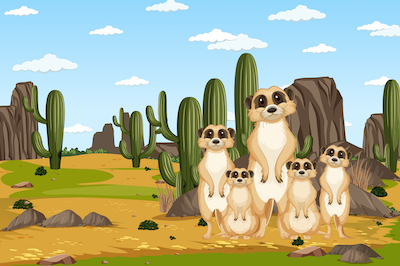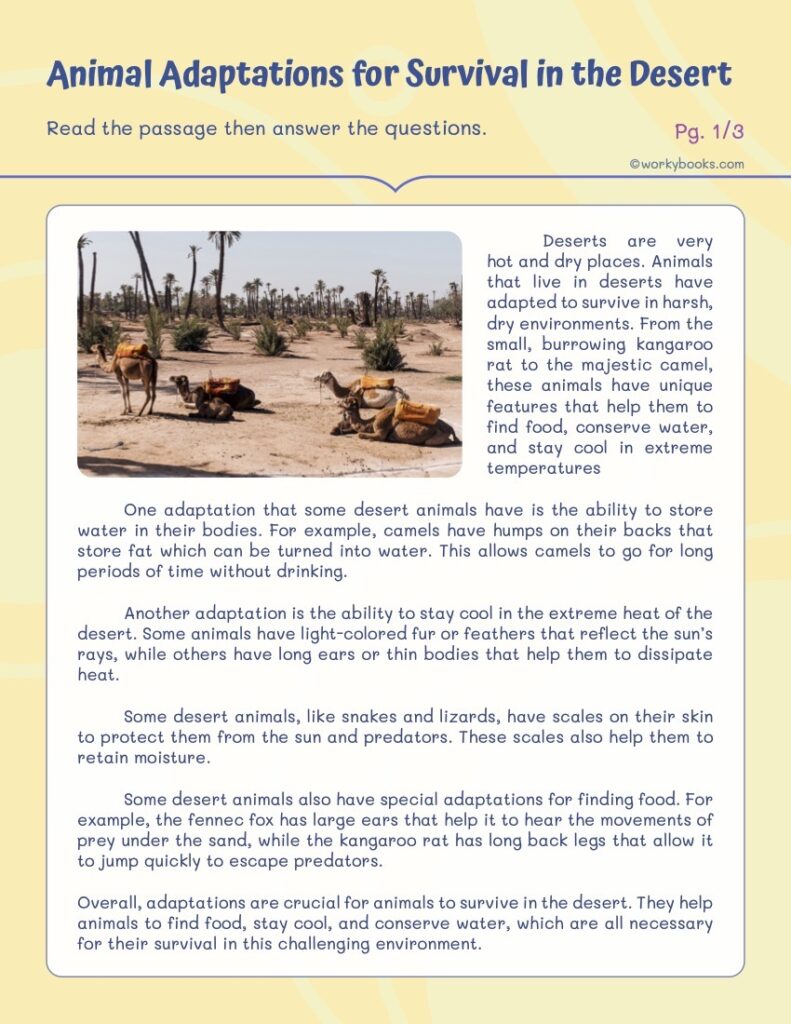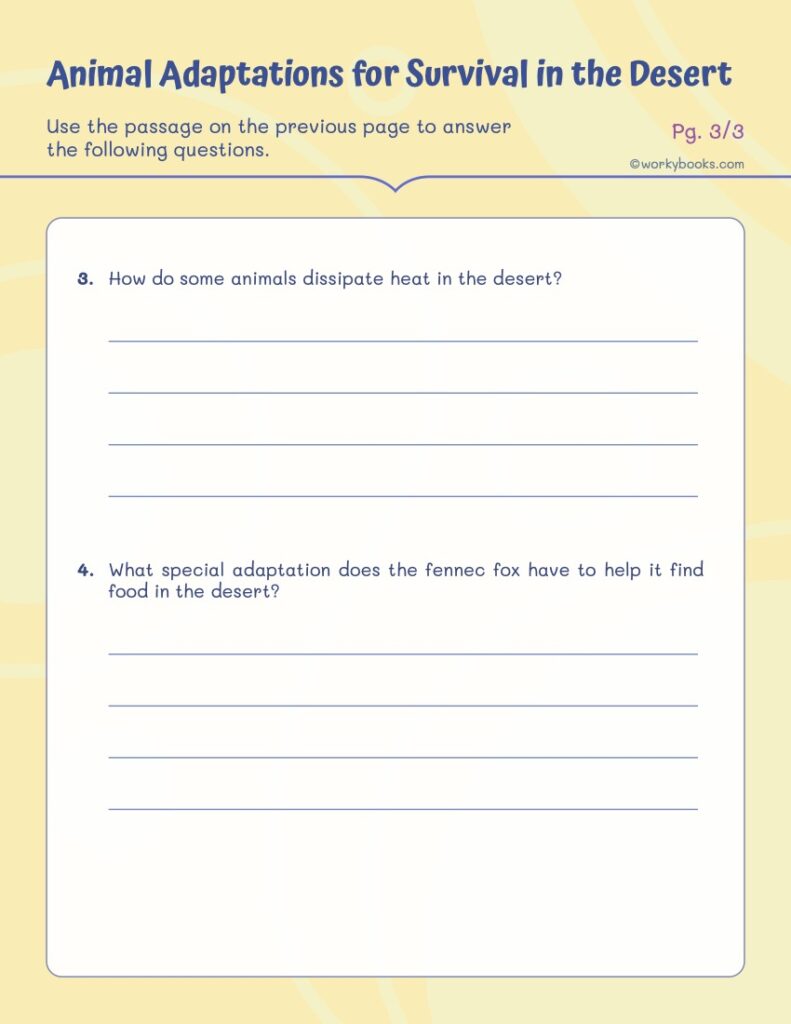What Animals Live in the Desert?

Some key desert animals that thrive in hot, arid desert environments include camels, foxes, lizards, snakes, roadrunners, rabbits, tortoises, sheep, and rodents. these animals live in the desert and have evolved adaptations like specialized kidneys, thermal regulation, and the ability to go long periods without water to live in desert ecosystems.
List of 20 Desert Animals for kids:
| 1. | Camel | 11. | Scorpion |
| 2. | Fennec fox | 12. | Rattlesnake |
| 3. | Coyote | 13. | Gila monster (Lizard) |
| 4. | Cactus wren | 14. | Black-tailed jackrabbit |
| 5. | Dung Beetle | 15. | Desert tortoise |
| 6. | Roadrunner (Bird) | 16. | Collared peccary |
| 7. | Kangaroo rat | 17. | Chuckwalla (Lizard) |
| 8. | Horned lizard | 18. | Desert bighorn sheep |
| 9. | Spadefoot toad | 19. | Desert Hedgehog |
| 10. | Desert iguana | 20. | Pronghorn |
How do animals adapt to the desert?
Animals that live in the desert habitat have evolved some truly incredible adaptations to survive the harsh conditions of this unique desert biome.From conserving water to enduring extreme temperatures, these remarkable adaptations allow desert animals to thrive where few others can. Here are some adaptations that help them survive and flourish in the desert habitat.
1. Conserving Water:
- Minimizing Water Loss: Many animals have thick fur or feathers for insulation, reducing sweating and keeping them cool. Some have specialized skin that prevents water loss, like camel’s thick skin or kangaroo rats’ water-resistant fur.
- Obtaining Water from Food: Some animals, like kangaroo rats, get most of their water from their food, needing little to no free water.
- Efficient Waste Disposal: Animals like kangaroo rats produce very concentrated urine, minimizing water lost through excretion.
- Nocturnal Activity: Many desert animals are nocturnal, avoiding the hottest part of the day and reducing water loss through sweating.

2. Regulating Body Temperature:
- Burrowing: Many animals spend the hottest part of the day in burrows underground, where temperatures are cooler and more stable.
- Large Ears: Fennec foxes and jackrabbits have large ears that radiate heat, helping them cool down.
- Light-coloured Fur or Feathers: Reflecting sunlight helps animals stay cooler.
- Behavioural Adaptations: Some animals, like meerkats, huddle together for shade or warmth, depending on the need.

3. Finding Food in Scarcity:
- Eating a variety of sources: Many animals are opportunistic feeders, consuming insects, fruits, seeds, and even carrion depending on what’s available.
- Storing Fat: Animals like camels store fat in humps, providing energy during lean times.
- Long Tongues and Specialized Adaptations: Some animals, like antelopes with long tongues, are adept at reaching leaves and water hidden in vegetation.
Beyond these, specific adaptations vary greatly among species, for example:
- Camels: Can store water in their hump, and their thick eyelashes and nostrils filter sand.
- Scorpions: Nocturnal with bioluminescent mates, they can burrow and have stingers for defence.
- Desert Tortoises: Can live for over 100 years and store water in their bladder for months.
Which of the following is not a common animal adaptation to desert conditions?
Q1. Desert animals have special features to help them survive the hot, dry conditions. Which of these features helps them stay cool at night?
- Having thick fur to keep them warm
- Burrowing underground during the day
- Storing water in their humps
- Having large ears to lose heat
The answer is (4). Large ears help radiate heat, which cools them down at night.
Q2. Some animals in the desert, like kangaroo rats, can survive without drinking any water. How do they get the water they need?
- They eat juicy fruits full of water.
- They absorb water from the morning dew.
- They get water from the food they eat, like seeds and insects.
- They store water in their fur like camels.
The answer is (3). Kangaroos rats get most of their water from the food they eat, not from fruits, dew, or storing it in their fur.
What desert animals live in the Sahara Desert?
The Sahara Desert, despite its harsh climate, is home to a surprisingly diverse array of animals! Here are some of the fascinating creatures you’d find there:
| Mammals: | Iconic herbivores: Fennec fox, addax antelope, Dorcas gazelle, scimitar-horned oryx, Barbary sheep, dama deer, Nubian wild ass. |
| Other notable mammals: Dromedary camels (introduced), goats, desert hedgehog, anubis baboon, spotted hyena, common jackal, sand fox, gerbils, jerboa,Cape hare. | |
| Reptiles: | Snakes: Saharan sand viper, deathstalker scorpion, desert horned viper. |
| Lizards: Desert monitor, various chameleons and skinks. | |
| Others: Desert crocodile (in permanent water sources). | |
| Birds: | Large Birds: Red-necked ostrich, secretary bird, lappet-faced vulture, desert eagle owl. |
| Smaller Birds: Sand lark, pale crag martin, brown-necked raven, fan-tailed raven,various raptors. | |
| Others | Insects: Saharan silver ant, dung beetle (important decomposers). |
| Arachnids: Scorpions, spiders. |
It’s important to note that this is just a small sampling of the incredible variety of life in the Sahara. Over 300 species of birds, 70 mammals, and 100 reptiles call this desert home!
Here is a free reading comprehension worksheet on Desert Animal Adaptations worksheet that is also aligned with CCSS.ELA-LITERACY.W.4.9.b. Students will read a passage that provides information about various adaptations that animals have developed to thrive in arid and harsh desert habitats
Animal adaptations for survival in the desert
- Deserts are very hot and dry places. Animals in the deserts have adapted to survive in harsh, dry environments. From the small, burrowing kangaroo rat to the majestic camel, these animals have unique features that help them to find food, conserve water, and stay cool in extreme temperatures
- One fascinating animal adaptation in the desert ecosystem is the ability of desert animals to store water in their bodies. For example, camels have humps on their backs that store fat, which can be converted into water. This adaptation allows camels to survive long periods in the desert ecosystem without drinking
- Another desert adaptation is the ability to stay cool in the extreme heat. Some animals have light-colored fur or feathers that reflect the sun’s rays, while others have long ears or thin bodies that help them to dissipate heat.
- Some desert animals, like snakes and lizards, have scales on their skin to protect them from the sun and predators. These scales also help them to retain moisture.
- Few desert animals also have special adaptations for finding food. For example, the fennec fox has large ears that help it to hear the movements of prey under the sand, while the kangaroo rat has long back legs that allow it to jump quickly to escape predators.
Overall, adaptations are crucial for animals to survive in the desert. They help animals to find food, stay cool, and conserve water, which are all necessary for their survival in this challenging environment.
Read the Passage then Answer the Questions
Q1.Write any skin adaptations that desert animals have developed to survive in their environment. Use evidence from the text to support your claim.
_______________________________________________________________________________________________________________
Q2.What is one adaptation that allows camels to go for long periods of time without drinking water?
_______________________________________________________________________________________________________________
Q3.How do some animals dissipate heat in the desert?
_______________________________________________________________________________________________________________
Q4.What special adaptation does the fennec fox have to help it find food in the desert?
____________________________________________________________________________________________________________________________________
Download this worksheet here!


Click here for Author’s Use of Reasons and Evidence Worksheet on Mountain adaptations.
Click here for free coloring pages on desert animals from out digital library!



